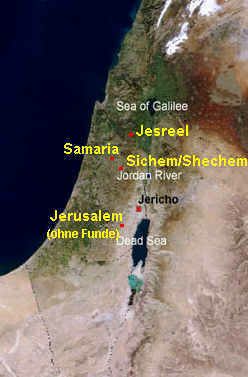from: Israel Finkelstein /
Neil A. Silberman: The Bible unearthed.
Archeology's New Vision of Ancient Israel and the
Origin of Its Sacred Texts; The Free Press, a division
of Simon & Schuster, Inc., 2001; German edition
has got the title "No trombones before Jericho" (orig.
German: "Keine Posaunen vor Jericho"): edition
C.H.Beck oHG, Munich 2002;
From German version "Keine Posaunen
vor Jericho" of DTV, Munich 2004, second edition of
2005. All page indications refer to the German
version. I hope the page numbers are not very
different.
The
contradictions concerning the life of the tribes in the
OT
-- the tribe Benjamin is said having been attacked by a
coalition of other Israelite tribes, and the coalition is
said having sworn that no marriage will be permitted any
more with the tribe of Benjamin (book of Judges, 19-21)
(p.112)
[Again we have here an ethnic racism with prohibition of
marriages]
-- according to the song of Deborah many tribes cannot be
loyal to God's law, get disloyal and are not doing it's
best for the "case of whole Israel" (p.112-113).
OT claims a danger of the 12
tribes from the beginning
OT claims:
The Israelite tribes are said having been encircled from
the beginning by enemies and by hostile enclaves in the
tribal territories having been in a dangerous position
from the beginning, in a military and in a religious way,
and the "people of Israel" is said having stood one
performance test after the other, with all possible
"heroic deeds", but these "heroic deeds" are only death
and murder:
-- according to the book of Judges 3,7-11, Othniel, a Calebite,
is said having repulsed the mysterious enemy
Kusan-Risathaim, the "king of Mesopotamia" in an action
alone
-- according to the book of Judges 3,12-30, Ehud from tribe of
Benjamin is said having killed the great and fat king of
Moab in his private room (p.114)
-- according to the book of Judges 3,31, Sambar is said having
killed 600 Philistines with one prick for bullocks (p.114)
-- Deborah and Barak are said having
startled the Israelite tribes against the staying
Canaanite kings in the North
-- according to the book of Judges 4,1-5,31 the wife of
the Kenite Heber,
Jael, is said
having killed the Canaanite General Sisera with a stake
during he was sleeping (p.114)
-- according to the book of Judges 6,1-8,28, Gideon from the
Manasseh tribe is said having executed a cultural
cleansing of the land against idolatry and is said having
defended his folk from the Midianite thieves who operated
from the desert (p.114)
-- according to the book of Judges 13,1-16,31, Simson is said having
seduced by Philistine Dalila
and is said having been robbed of his curls (p.114), and
then he is said having been blinded and humiliated in Gaza
(p.114-115) and [after the hair was growing again] he is
said having destructed the columns of the big Philistine
Dagon temple in Dan (p.115)
[perhaps a suicide attack].
The facts of archeology: There was a
reconstruction on or besides the ruins - and there was a
legend formed
The real life of the Israelites is
hardly mentioned in OT, neither in the book of Joshua
(p.115) nor in the book of Judges (p.115-116). According
to Finkelstein / Silberman the Israelites - after having
migrated during 40 years in the desert and after 10 years
of wars of conquest - were badly prepared for a peasant's
life in a completely destroyed country (p.116)
[respectively there had been famine and
mass death, or the neighboring "enemies" had converted
into "friends" sharing the food, or other enemies from
abroad had defeated the weak Israelis and had accepted
well the "preparatory work"].
since 1100 B.C. appr.
Reconstruction
of Canaan - independences of later territories of Shechem
and Jerusalem are not affected
|

Map with Shechem,
Samaria, Jezreel, and Jerusalem. For Jerusalem
there are no findings for this period.
|
The Philistines in
the Canaanite plain are working for their power and
gaining the power in the towns back. The independences of
the city states in the highlands (territories of future
kingdoms of Shechem and of Jerusalem) is not affected
(p.178).
The Phoenician descendants of Canaanites
are occupying the harbor towns in the North (p.178-179).
Megiddo and other towns are amplified.
Megiddo is reconstructed as a representative town.
Archaeologically there can be shown the whole development
in Megiddo in the layers (Stratum VIA). The refoundation
contains practically all characteristics of the former
Canaanite culture
-- with a similar ceramic stile as in
12th century B.C.
-- with a similar layout as in 12th
century B.C.
-- with Canaanite temple complexes etc.
(p.179).
Such a development also have Tel Dor and
Tel Rehov. But this new growth is not for a long time
(p.179).
Rubble
mountains provoking legend forming - example Bethel
It can be admitted that the huge rubble
mountains of the towns had a tremendous effect in the
memory of the population.
According to Bible researchers Alt and
North there are legends formed with the topic of the
rubble mountains with all possible heroism,
-- because the painful experience of a
destruction of a town is not passing without effect
-- but the memory is always more blurred
and is becoming the rough material for all possible
legends and claims (p.107) [with the climax of the legends
in OT since 7th century B.C.[.
In the case of the town of Bethel for
example the huge rubble mountain ("tell") in the East with
the ruins from Late Bronze Age is 10 times bigger than the
reconstructed city (p.106).


